Gioia del Colle
Gioia del Colle | |
|---|---|
| Comune di Gioia del Colle | |
| Coordinates:40°48′N16°56′E/ 40.800°N 16.933°E | |
| Country | Italy |
| Region | |
| Metropolitan city | Bari(BA) |
| Frazioni | Colonia Hanseniana, Corvello, La Torre, Casino Eramo e Marzagaglia,Monte Sannace,Montursi,Murgia, Santa Candida, Terzi, Villaggio Azzurro |
| Government | |
| • Mayor | Giovanni Mastrangelo (right wing) |
| Area | |
| • Total | 206.48 km2(79.72 sq mi) |
| Elevation | 360 m (1,180 ft) |
| Population (1 January 2015)[2] | |
| • Total | 27,923 |
| • Density | 140/km2(350/sq mi) |
| Demonym | Gioiesi |
| Time zone | UTC+1(CET) |
| • Summer (DST) | UTC+2(CEST) |
| Postal code | 70023 |
| Dialing code | 080 |
| ISTATcode | 072021 |
| Patron saint | Saint Philip Neri |
| Saint day | 26 May |
| Website | Official website |
Gioia del Colle(pronounced[ˈdʒɔːjadelˈkɔlle];Barese:Sciò) is a town andcomuneof theMetropolitan City of Bari,Apulia, southern Italy. The town is located on theMurge plateauat 360 metres (1,180 ft) above sea level, between theAdriaticandIonianseas.
Physical geography
[edit]Territory
[edit]
Gioia del Colle is on the top of a hill at 360m a.s.l.It is located in the southern part of theMurge,in the "Sella di Gioia del Colle". It is between the North-West Murge and the South-West Murge and theAdriatic Seaand theIonian Sea.The municipal area has an area of 206.48 km2and it reaches a maximum altitude of 435 m a.s.l. and a minimum of 296 m a.s.l. Its area borders to the North-West withAcquaviva delle Fonti,to the North withSammichele di Bari,to the North-East withTuri,to the East withPutignanoandNoci,to the South-East withMottola,to the South withCastellaneta,to the South-West withLaterzaand to the West withSanteramo in Colle.
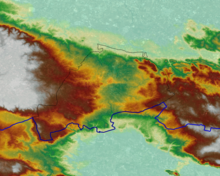
The landscape is characterized by large wooded areas, in which theMacedonian oaksdominate, more than thedowny oak.In particular theBosco Romanazziand Serra Capece constitute the most conspicuous part of the wooded area of Gioia del Colle and they extend fromMount Sannacearchaeological area to the provincial road that leads toNoci.
The western part of the area is part of the North-WestMurge,with isoipse that exceed 400 m a.s.l. towardsSanteramoandLaterza,while the Eastern one is part of the South-East Murge, with isoipse over 400 m a.s.l. towardsNoci.In the middle, on the contrary, there is a depression (saddle) with an average altitude of 340 m a.s.l., interrupted only by the 360-meter hill on which the city lies.
Climate
[edit]Gioia del Colle's climate ismediterranean(KöppenCsa), but it has peaks ofcontinentalitydue to the altitude and the distance from the sea. Temperature varies between −2 e +12 °C in winter, while it varies between +18 e +35 °C with a high percentage of humidity in summer. Annual rainfall is around 600 mm. It often snows, about once a year, especially if there is cold air of Balkan origin.
| Climate data for Gioia del Colle (Gioia del Colle Air Base), 1991–2020 | |||||||||||||
|---|---|---|---|---|---|---|---|---|---|---|---|---|---|
| Month | Jan | Feb | Mar | Apr | May | Jun | Jul | Aug | Sep | Oct | Nov | Dec | Year |
| Mean daily maximum °C (°F) | 10.3 (50.5) |
10.8 (51.4) |
13.8 (56.8) |
17.4 (63.3) |
22.8 (73.0) |
28.0 (82.4) |
30.8 (87.4) |
31.1 (88.0) |
25.6 (78.1) |
20.5 (68.9) |
15.4 (59.7) |
11.3 (52.3) |
19.8 (67.6) |
| Daily mean °C (°F) | 6.3 (43.3) |
6.5 (43.7) |
8.9 (48.0) |
12.0 (53.6) |
16.8 (62.2) |
21.8 (71.2) |
24.4 (75.9) |
24.5 (76.1) |
19.8 (67.6) |
15.6 (60.1) |
11.4 (52.5) |
7.6 (45.7) |
14.6 (58.3) |
| Mean daily minimum °C (°F) | 2.5 (36.5) |
2.5 (36.5) |
4.4 (39.9) |
7.0 (44.6) |
11.0 (51.8) |
15.5 (59.9) |
17.9 (64.2) |
18.3 (64.9) |
14.7 (58.5) |
11.2 (52.2) |
7.6 (45.7) |
3.9 (39.0) |
9.7 (49.5) |
| Averageprecipitationmm (inches) | 60.2 (2.37) |
52.4 (2.06) |
64.7 (2.55) |
51.3 (2.02) |
43.0 (1.69) |
36.5 (1.44) |
24.1 (0.95) |
24.5 (0.96) |
69.4 (2.73) |
65.6 (2.58) |
78.5 (3.09) |
69.5 (2.74) |
639.8 (25.19) |
| Average precipitation days(≥ 1 mm) | 7.5 | 7.3 | 6.9 | 6.8 | 5.5 | 4.1 | 2.8 | 2.6 | 5.9 | 7.0 | 7.7 | 8.3 | 72.3 |
| Averagerelative humidity(%) | 79.6 | 75.9 | 74.2 | 73.4 | 70.4 | 65.5 | 63.0 | 64.5 | 70.7 | 77.1 | 80.8 | 80.9 | 73.0 |
| Averagedew point°C (°F) | 3.5 (38.3) |
2.9 (37.2) |
4.9 (40.8) |
7.5 (45.5) |
10.9 (51.6) |
13.9 (57.0) |
15.3 (59.5) |
16.2 (61.2) |
14.5 (58.1) |
12.2 (54.0) |
8.8 (47.8) |
5.0 (41.0) |
9.6 (49.3) |
| Source:NOAA[3] | |||||||||||||
History
[edit]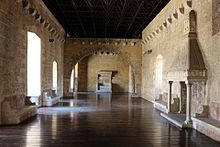
The current town of Gioia del Colle was born aroundCastello Normanno-Svevo,a castle ofByzantineorigins.
Its name derives from Joha, a reduction of the surname Joannakis. It was a Byzantine family present in these places in the Middle Ages,[4]but there are many opinions and even legends on the origin of the toponym. One of the most famous is that according to a noble woman traveling in the lost area of jewels including a beautiful and precious necklace. The name "Gioia del Colle" was given to the place where the necklace was found. The complex and original history of the city of Gioia del Colle is also illustrated in its particular heraldic coat of arms: a goblet-shaped cup full of jewels and bordered by agricultural motifs. Unlike the coats of arms of the neighboring countries, that of Gioia del Colle, dating back to 1934, is not linked to any symbol depicting families, marquisates or duchies. It tells the presence of a heterogeneous civilization ranging from poverty to wealth, from crafts to large estates. It is inspired by a sculpture made in 1480 by Joannes de Rocca, on a stone walled in the University of Gioia's seat. It depicts three coats of arms: that of Gioia with the inscription Universitas Joe, the Aragonese one with the royal crown and that of the Acquaviva counts of Conversano.
The inhabited area was rebuilt by the NormanRichard of Hauteville,only to be destroyed byWilliam I of Sicily.It was re-founded in 1230 byFrederick II of Swabiaon his return from the Crusade. It seems that the castle was a residence where he stopped during his hunting trips. It was then completed by the Angevins who opened windows on the curtain.
Between 1600 and 1800 the successive owners (Acquaviva d'Aragona,theDe Mariand Donna Maria Emanuela Caracciolo) removed the appearance of a fortified residence from the complex.
The "new" city, however, would have originated from a much older settlement: Monte Sannace, about 5 km away from today's town. Archaeological excavations, even today, bring to light the remains of a village ofPeucetiansdating back to the 7th century BC. Gioia was born during the Byzantine dominion and then passed under the Norman dominion, it was given to Count Richard of Hauteville. Frederick II was responsible for the reconstruction of the castle. It wasprincipality of Tarantoand fief of the De Mari princes ofAcquaviva delle Fontiuntil the abolition of feudalism.

Marzagaglia's massacre
[edit]In 1920 theMarzagaglia massacretook place, in the difficult social and political climate of the first post-war period.[5]On 1 July 6 workers were killed and following day in retaliation three landowners.
Monuments and interesting places
[edit]Norman-Hohenstaufen castle
[edit]
The Gioia del Colle Norman-Swabian Castle is the result of at least three construction interventions: one dating back to theByzantineperiod, another to theNormanone and the last to the Swabian one. Initially it consisted of a fortified enclosure in stone ashlars. It was enlarged in the 12th century by the NormanRichard of Hauteville,who transformed it into a noble residence.
The final castle arrangement is due toFrederick II of Swabiaaround 1230. It has a quadrangular courtyard, halls and rooms that overlook it, and is bordered by four corner towers. Of the four original corner towers, which are mentioned in the book the Terra di Gioia both by the architect and tabular book Honofrio Tangho of 1640 and by Gennaro Pinto of 1653, today only two towers remain: that of De 'Rossi and that of the Empress.
The castle permanently houses theGioia del Colle National Archaeological Museum.

The main Church
[edit]It was built towards the end of the 11th century by Riccardo Siniscalco with the name of "Palatine Church of St. Peter". It was initially dedicated toSt. Peter,but it was later renamed "Madonna della Neve". The church was destroyed in 1764 by a fire. In the same year the church was rebuilt and dedicated to the nativity of theBlessed Virgin.This period dates back to the two stone sculptures on the front (S. Filippo Neri and the Madonna with the Child in her womb).
The church was damaged again in 1857, by an earthquake. It was then closed to worship. The church's front and the bell tower were restored in 1893.
The downfall of the bell tower dates back to 1942 and it is due to structural instability between the part built in the 12th century and that of 1893.
The Baptismal Books were established in the church in 1575 and the Registers of the Dead in 1584.
It has inside numerous frescoes dating back to different historical periods and a crypt in which the body of Prince Carlo III De' Mari is buried. It was rebuilt over the centuries, it still retains the original jamb of the entrance door and asarcophagusused as a washbasin (preserved in the sacristy).
Other churches
[edit]- Parrocchia Sacro Cuore
- Parrocchia Santa Lucia
- Parrocchia San Vito
- Parrocchia Immacolata di Lourdes
- Parrocchia Madonna di Loreto
- Chiesa San Rocco
- Chiesa Sant'Angelo
- Chiesa Sant'Andrea
- Chiesa San Domenico
- Chiesa San Francesco
- Chiesa del Crocifisso
- Chiesa della Candelora
- Chiesa Maria SS.Annunziata
- Chiesa San Giuseppe lavoratore
Old town's arches
[edit]Cassano distillery
[edit]Gioia area has always been interested in an important wine production, which in the past centuries found a market especially in France. When this trade was closed as a result of theprotectionist measuresof 1887 between Italy and France, producers began distilling the large quantities of unsold wine to producecognacand alcoholic beverages.[6]
Following the example of others, in 1891 Paolo Cassano had adistilleryset up inside the Cassano farm. The activity of the factory continued until 1914 (in this period the Italian Fides Cognac was born, the best known cognac produced in Gioia), when the company was put into liquidation due to a series of concomitant negative factors that had reduced it excellent profitability. First of all an epidemic ofphylloxerawhich decimated the vineyards of the whole Puglia; furthermore, in 1912 there was a notable increase in taxation together with the abolition of tax rebates for cognac producers.[7]
The distillery passed to the Taranto family which kept in a state of neglect. In 1970 it was then sold to the USL (today public local health authority) to renovate it into a hospital. In 1997 the building was again sold to the municipality of Gioia del Colle.
The ancient distillery represented a pioneering example of the Apulian industry. Due to these considerations the Ministry of Cultural and Environmental Heritage has sanctioned its historical importance with the inscription in the list of monumental and environmental assets with a binding decree of 26 September 1992.
Renovated since 2006, the distillery occasionally hosts exhibitions and festivals, such as the mozzarella festival held in August.
Natural areas
[edit]TheBoschi Romanazziare anoasismanaged byWWF Italy.
Society
[edit]Demographic evolution
[edit]Registered inhabitants:[8]

Foreign ethnicities and minorities
[edit]Culture
[edit]
Instruction
[edit]Schools
[edit]In Gioia del Colle there are 5kindergartens,4 primary schools and 2lower secondary schools.The secondary schools which are located in the city are: the "Ricciotto Canudo"liceo scientifico,the "Publio Virgilio Marone"liceo classicoand the "Galileo Galilei"industrial technical institute.
Museums
[edit]National archeologic museum
[edit]The Archaeological Museum's rooms are set up inside theNorman-Hohenstaufen Castle.There is a systematic exposure of the numerous grave items from the necropolis ofMount Sannaceand Santo Mola which cover a wide chronological period. From the beginning of the6thto the 2nd century BC. geometric and figurative vases, bronze weapons, fibulae andclaystatuettes define the usual composition of the funerary objects of the indigenous center but also of the widerPeucetecommunities.
Monte Sannace Archaeological Park
[edit]The site is 5 km away from the town in the direction ofTuriand it has been the subject ofarchaeological excavationssince 1957 by theSuperintendenceof Antiquities of Puglia and Matera. The excavations have been completed in 1961, they brought to light a settlement of the ancientPeucezidating back to the 9th century BC. which lasted, with brief interruptions, until the Hellenistic-Roman period (approximately until the 1st century AD).
The archaeological park includes some defensive circuits' areas and the north gate includes numerous tombs and various buildings of the acropolis, as well as a large part of the town.
The finds from the excavations are kept in theNational Archeological Museumlocated inside the Norman-Swabian Castle.
Cinema
[edit]Besides having given birth toRicciotto Canudo,who during his stay in Paris increased the debate around the art of cinema, Gioia del Colle is linked to cinema for having hosted the set of three films, in different eras:
- Between 1930 and 1931 some shots of the silent filmIdillio,directed by MilaneseNello Mauri,were shot in the city center and in the countryside around Gioia.
- In 1964Pier Paolo Pasolinifor the filmThe Gospel According to St. Matthewwhose Gioia del Colle Castle to shoot two scenes:Herod's palace and Salomé's dance, which took place in the north wing of the building's courtyard. The expulsion from the temple, with the priests who attend the events, was filmed – instead – inCastel del Monte.
- In 1999,Terra bruciatawas set there,Fabio Segatori's debut film withRaoul Bova,Giancarlo Giannini,Michele PlacidoandBianca Guaccero.[9]
- In 2014Matteo Garronechose the Norman-Swabian castle of Gioia del Colle to set some scenes from the filmTale of TaleswithSalma Hayek,Vincent CasselandToby Johnes.
Music
[edit]- The Gioia del Colle Music Band won the Venice International Competition in 1924 and the Professional Competition in Rome in 1929.
- Since 1998 the international music competition Pietro Argento Award has been held in Gioia del Colle.
- In 2012, from the initiative of numerous musicians from Gioia, Rockerella was born, a project of production, historical research, census and coordination of alternative music by Gioia del Colle, which becomes a festival of the same name and produces two compilations[10]and the documentary "Rockerella, history of Gioia del Colle's music from the 1950s to the present day".[11]
Theaters
[edit]- Rossini municipal theater
Events
[edit]- Festa Patronaledi San Filippo Neri, 25 – 26 – 27 maggio;
- Festa del compatrono San Rocco, 15 – 16 agosto;
- Processione deiSacri Misteri della Passione,Venerdì Santo;
- Festival InternazionaleTeatroLab2.0 – Chièdiscena,aprile – maggio;[12]
- Palio delle Botti,agosto.[13]
Economy
[edit]Gioia del Colle is famous for its mozzarella and Gioia del Colle Primitivo wine. There are also important producers of pasta and extra virgin olive oil. Agriculture, dairy industries, cellars, pasta factories and oil mills together with commercial enterprises represent the economic engine of this country. Ansaldo Caldaie was present with a plant for the construction of large industrial boilers, a leader in the international field.
Red, white,rose,sweetdolceandfortifiedliquorosowines are permitted in theItalian wine DOCof the area. Red androsewine grapes are limited to aharvestyield of 12 tonnes/ha while white wine grapes are limited to a yield of 13 tonnes/ha. The reds androsesare a blend of 50–60%Primitivo,a 40–50% blend component ofMontepulciano,Sangiovese,NegroamaroandMalvasia(with Malvasia being further limited to a 10% maximum). The whites are composed of 50–70%Trebbianowith other permitted local grape varieties, such asPampanuto,making up the remainder. AvarietalPrimitivo wine is permitted, provided the wine is 100% composed of the grape with yields limited to 8 tonnes/ha and a minimumalcohol levelof 13%. Thedolcewine of the area is composed of at least 85%Aleaticowith a 15% maximum blend component of Malvasia, Negroamaro and Primitivo making up the rest. The grapes must also be limited to a harvest yield of 8 tonnes/ha and have a minimum alcohol level of 15%. Theliquorosoversion must have a minimum alcohol of 18.5%.[14]
Infrastructure and transport
[edit]Streets
[edit]The main Gioia del Colle's road districts of Gioia del Colle are:[15]
- Autostrada A14Bologna-Taranto,Gioia del Colle exit.
- Strada statale 100 di Gioia del Colle.

The train station is on theBari-Taranto railwayand it isGioia del Colle-Rocchetta Sant'Antonio line.
Airports
[edit]The36th Stormoof the Italian Air Force is atGioia del Colle "Antonio Ramirez" air base.
Urban mobility
[edit]Urban public transport is a service made available by the municipal administration and managed by the Sabato Viaggi company. The network consists of two circular lines, two lines serving the Termosud area, two lines for the industrial area and two lines connecting the main school sites in the municipality of Gioia del Colle.
Administration
[edit]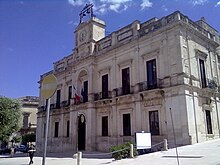
| Period | Office holder | Party | Title | Notes | |
|---|---|---|---|---|---|
| 15 novembre 1986 | 18 giugno 1991 | Angelo Longo | DC | Sindaco |
| 18 giugno 1991 | 21 dicembre 1991 | Giuseppe Gallo | DC | Sindaco |
| 21 dicembre 1991 | 11 agosto 1992 | Vincenzo Martinelli | DC | Sindaco |
| 11 agosto 1992 | 28 gennaio 1993 | Antonio Domenico Ludovico | DC | Sindaco |
| 28 gennaio 1993 | 10 settembre 1993 | Pasquale De Leonardis | DC | Sindaco |
| 10 settembre 1993 | 8 maggio 1995 | Luciana Perrotta Ubaldo Basta Luciano Marzano |
Commissione straordinaria |
[16] |
| 8 maggio 1995 | 14 giugno 2004 | Sergio Povia | PDS/DS | Sindaco |
| 14 giugno 2004 | 23 ottobre 2007 | Vito Mastrovito | DS | Sindaco |
| 23 ottobre 2007 | 29 aprile 2008 | Claudio Palomba | Commissario |
| 29 aprile 2008 | 7 novembre 2011 | Piero Longo | PdL | Sindaco |
| 7 novembre 2011 | 22 maggio 2012 | Maria Filomena Dabbicco | Commissario |
| 22 maggio 2012 | 9 marzo 2015 | Sergio Povia | PD | Sindaco | [17] |
| 9 marzo 2015 | 23 giugno 2016 | Rossana Riflesso | Commissario |
| 23 giugno 2016 | 18 maggio 2018 | Donato Lucilla | lista civica | Sindaco |
| 18 maggio 2018 | 27 maggio 2019 | Umberto Postiglione | Commissario |
| 27 maggio 2019 | in carica | Giovanni Mastrangelo | centrodestra[18] | Sindaco |
Twinning
[edit]Other administrative information
[edit]Gioia del Colle is the capital of theSouth-East Murgia Barese mountain community,which groups together 6 municipalities.
Sport
[edit]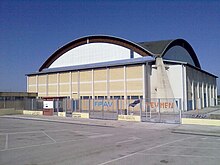
Football
[edit]The mainfootballteam in the city was theA.S.D. Pro Gioia,which played in Group B of theFirst Categoryuntil 2011. It was founded in 1911. The company colors are yellow and black. Currently there is the Partizan Gioia which plays in the Second Category.
Volleyball
[edit]The localvolleyballteam is the New Real Volley Gioia which plays in theItalian A2 series of men's volleyball.The company colors are white and red. The team inherits the glories of the ASPC Volley Gioia and theGioia del Volleycompany which boasted 4 seasons in the top flight:1994–1995,1995–1996,2003–2004and2004–2005as well as a Serie A2 Italian Cup final. Currently the structure that hosts the home matches of the New Real Volley Gioia is thePalaCapurso,a sports hall in Gioia del Colle.
After the excellent volleyball tradition started by the main team since 1975, other realities started in the national volleyball scene. The A.S.D. New Volley Joy of women's volleyball plays in the 2012–2013 season in thewomen's Serie C.[20]
Other sports
[edit]Localrugbyteam Federiciana Rugby A.S.D. was founded in 2010. It plays in the Apulian Serie C of theItalian Rugby Federation.In 2013 the team was refounded taking the name of Rugby Club Granata A.S.D., relying on a new technical guide. In 2017 the team is tinted pink, to become a women'srugby team at 7.
Basketball is played at a youth level. The A.S.D. Gioia Running was founded in 2012 and it participates in running competitions at the regional level.
Paolo Cantore, Patrizia Castellaneta and Vito Acito are militants in the A.S.D. Archers of the Murgia. They are athletes and they several times won the FITARCO regional title in the discipline of archery. Patrizia Castellanete in 2011 won the title of absolute Italian champion and Paolo Cantore in 2014 won the title of Italian team champion.
Sport systems
[edit]The local stadium is named "P. Martucci" and it is used by the local football teams. TheF.I.G.C.-L.N.D. objected to the use of the facilities for rugby matches.Palasport Gioia del Colleis used for volleyball and basketball and it is called PalaCapurso. Finally, there are the PalaKoutnetsov, known as 'Palestrone' where the youth sector matches of Team Volley Joya (the Academy), of New Volley Gioia (Women's C Series) are hosted as well as matches of the youth championships of other Gioia volleyball teams.
People
[edit]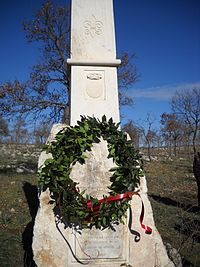
- Gigi Angelillo,actor.
- Ricciotto Canudo,intellectual and theorist of the cinema.
- Nicola Legrottaglie,Italian association football player.
- Maurizio Vasco, author and journalist, living in New York City.
- Bob Pisani,journalist CNBC, whose grandfather was from Gioia del Colle
- Frank Stallone Sr.,father ofSylvester Stallone,born in Gioia del Colle before emigrating to the United States
- Sergeant Romano,of theBourbonarmy. (it.)
- Sebastiano Cantore, actor and character of TV Series "Sebian"
- Pasquale Petrera, grandfather of Pasquale Petrera, MD, born in Gioia before emigrating to the US in 1919.
Trivia
[edit]- The songL'onorevole BricollebyClara Jaione(1948), whichClaudio Villalater famously interpreted,[21]is about the wry story of a fictitious "Honorable Bricolle, aMember of Parliamentfrom Gioia del Colle ".
References
[edit]- ^"Superficie di Comuni Province e Regioni italiane al 9 ottobre 2011".Italian National Institute of Statistics.Retrieved16 March2019.
- ^Population fromISTAT.
- ^"Gioia del Colle Climate Normals 1991–2020".World Meteorological Organization Climatological Standard Normals (1991–2020).National Oceanic and Atmospheric Administration. Archived fromthe originalon 28 August 2023.Retrieved27 August2023.
- ^Berloco, Roberto (16 November 2013)."PERLE DI STORIA PUGLIESE / Gioia del Colle, origini bizantine per una storia di tutto rispetto (3° puntata)".Giornale di Puglia.Archivedfrom the original on 22 June 2017.
- ^Ottani, Ermando."L'Eccidio di Marzagaglia (1° luglio 1920)".Storia e futuro(in Italian).Archivedfrom the original on 9 June 2013.
- ^Paradiso, Domenico (2020),Padroni del vapore – l'industria gioiese da fine '800 a metà '900,Comune di Gioia del Colle – Assessorato alla Cultura
- ^Dentico, Pino; Ponte, Nunzio (1991).Le ciminiere mute – l'avventura di un'impresa pugliese fra Ottocento e Novecento.Fasano: Schena Editore.
- ^Statistiche I.Stat-ISTAT;URL visited on 28-12-2012.
- ^Alfonso Marrese. Apulia Film Commission.
- ^Giulia, Sabia (25 July 2012)."Rockerella Festival, oltre ogni previsione".
- ^"Rockerella, il documentario sulla storia della musica gioiese, dagli anni '50 ai giorni nostri"(in Italian). 20 July 2017.
- ^"Festival Teatro Lab 2.0 Gioia del Colle".ANSA(in Italian). 23 April 2019.
- ^"Sito ufficiale Palio delle Botti".
- ^P. Saunders,Wine Label Languagep. 167, Firefly Books 2004ISBN1-55297-720-X.
- ^"MapQuest Maps – Driving Directions – Map".
- ^Consiglio comunale sciolto per infiltrazioni mafiose conDecreto del Presidente della Repubblica 10 settembre 1993Archived9 October 2018 at theWayback Machine.
- ^Sospeso dalla carica del 5 febbraio al 9 marzo 2015.
- ^Lega,FI,FdIe 3 civiche.
- ^"Gemellaggio Gioia del Colle -Targoviste: GIOIADELCOLLE.INFO – Il portale di Gioia del Colle"(in Italian).Retrieved18 December2020.
- ^"Sito ufficiale della ASD New Volley Gioia".Newvolleygioia.16 March 2012. Archived fromthe originalon 16 March 2012.
- ^ironic video of the historical interpretation of Claudio Villa(YouTube).
Bibliography
[edit]- Vincenzo Tuccillo.La nostra Gioia del Colle.Fasano,Schena Editore, 1998.ISBN88-8229-080-8.
- A. Ciancio, C. Colafemmina, C. D'Angela, A. Donvito, M. I. Gatti, M. Girardi, F. Matarrese, R. Striccioli, M. Tondo, A. M. Tripputi.Gioia – Una città nella storia e civiltà di Puglia.Fasano, Schena Editore, 1986.ISBN88-7514-139-8.
- L. Bertoldi Lenoci, A. Ciancio, A. Donvito, L. Fico, M. Girardi, N. Lavermicocca, O. Liuzzi, V. Marinelli, A. Muscedra, T. Piacente, D. Posa, G. Salvatori, A. Siciliano, R. Striccioli.Gioia – Una città nella storia e civiltà di Puglia. Vol. 2.Fasano, Schena Editore.ISBN88-7514-252-1.
- E. Cavalieri, P. Cordascio, E. M. De Juliis, A. Donvito, M. Donvito, M. Girardi, F. Magistrale, A. Muscedra, V. Marinelli, A. Muscedra, F. S. Perillo, L. Rossi, A. Siciliano, F. Terzulli.Gioia – Una città nella storia e civiltà di Puglia. Vol. 3.Fasano, Schena Editore, 1992.ISBN88-7514-529-6.
- Nicola Bitetti.Le chiese di Gioia nella storia e nell'arte.Fasano, Schena Editore, 1986.
- Pino Dentico, Nunzio Ponte, (1991), Le ciminiere mute – l'avventura di un'impresa pugliese fra Ottocento e Novecento, Fasano, Schena Editore
- Adolfo Armando Celiberti,Pagine di storia gioiese,in "Archivio Storico Pugliese", anno XIV (1961).
- Vito Umberto Celiberti,Storia documentaria di Gioia Del Colle, dalle origini a roberto D'Angiò,Bari 2000. Cfr. ancheDa Monte Sannace a Gioia "Storia di due città",Bari 2002




